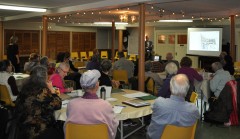by Kelsey Curtis, CFICE Volunteer
Nestled between Main Street, the Rideau River and St. Paul’s University, is 26 acres formerly known as the Oblate lands. This space, currently owned by The Regional Group, an Ottawa real-estate developer, is what the Innovative Housing for Older Adults (IHOA) group hopes will one day be the site of a proposed cohousing community for older adults.

A large group of senior citizens listen to a presentation on redeveloping Greystone Village. ©Magda Goemans
To help the IHOA influence how the Oblates land, now known as Greystone Village, is developed, Community First: Impacts of Community Engagement (CFICE) has partnered with Sustainable Living Ottawa East (SLOE), a citizen group that advocates for sustainable development in Old Ottawa East. By assembling research on site-specific sustainable methods of development, SLOE and CFICE are helping the IHOA build their case for a sustainable cohousing community that can then be presented to The Regional Group for consideration.
“The goals of this project are to bring together a community of older adults, within a housing community of 40 units to go in Greystone Village, where residents have a say over the aging process and how they live. It is being planned as a community where people can take care of each other as they age. There are also plans to accommodate some affordable housing for older adults with lower incomes,” says Magda Goemans, a research assistant for CFICE’s Community Environmental Sustainability hub.
With support from CFICE, SLOE and the IHOA, along with a coalition of groups including Sandy Hill Community Health Centre and Centretown Citizens Ottawa Corporation, have worked towards these goals to influence a visionary redevelopment of Greystone Village. As part of her work with CFICE, Goemans supports the research and coordination needs of SLOE and the IHOA. Recently, Goemans helped the IHOA organize a finance and ownership workshop to discuss affordability options for the proposed cohousing community.
“The affordability component is really important to us,” said Rebecca Aird of IHOA. “The concept of affordability will help us think through how redevelopment could be approached.”

Senior citizens work in small groups to discuss financing options as part of the IHOA workshop. ©Magda Goemans
The City of Ottawa has a target of 25 per cent affordability for all new developments. The City of Ottawa deems housing as affordable when people at the 30 per cent and below income level are spending only 30 per cent of their income on housing.
“If we can meet that target, that would be amazing,” said Aird with regard to Greystone Village.
City of Ottawa support for the IHOA’s proposal would mean the possibility of opening the cohousing community up to the City’s waiting list for affordable subsidized housing. In Ottawa, this list includes more than 2,000 seniors. The concern among some workshop attendees was that, if they offered housing opportunities to persons on the City of Ottawa’s social housing list, some living in the IHOA housing community might not share the same community-engagement values. However, others at the workshop fully supported the idea.
The project is in the midst of discussing options and many important decisions will not be made until later on in the process. Still, Aird is very optimistic about the progress these groups have made and their enthusiasm for the project.
“I’m totally confident with the skills in this room that this is a group that can do it. By doing it, we’ll also create hope and possibility for people doing similar things,” she said.